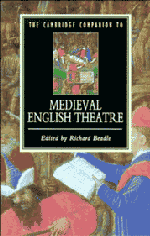Book contents
- Frontmatter
- 1 An introduction to medieval English theatre
- 2 The theatricality of medieval English plays
- 3 The York cycle
- 4 The Chester cycle
- 5 The Towneley cycle
- 6 The N-Town plays
- 7 The non-cycle plays and the East Anglian tradition
- 8 The Cornish medieval drama
- 9 Morality plays
- 10 Saints' plays
- 11 Modern productions of medieval English plays
- 12 A guide to criticism of medieval English theatre
- Select bibliography
- Continued Series List
- Index
1 - An introduction to medieval English theatre
Published online by Cambridge University Press: 28 May 2006
- Frontmatter
- 1 An introduction to medieval English theatre
- 2 The theatricality of medieval English plays
- 3 The York cycle
- 4 The Chester cycle
- 5 The Towneley cycle
- 6 The N-Town plays
- 7 The non-cycle plays and the East Anglian tradition
- 8 The Cornish medieval drama
- 9 Morality plays
- 10 Saints' plays
- 11 Modern productions of medieval English plays
- 12 A guide to criticism of medieval English theatre
- Select bibliography
- Continued Series List
- Index
Summary
You that love England, who have an ear for her music ... Listen. Can you not hear the entry of a new theme?
During the last few decades, the 'new theme' of medieval English theatre may be said to have swelled beyond all expectation. In the place of the modest harmonious arias of a few soloists we now confront a mighty but not totally co-ordinated anthem issuing from a many-throated chorus. In the past thirty years the status of medieval plays has been transformed, not merely through the advocacy of academics, but by the enthusiastic response of students and, even more remarkably, spectators. Much of the main repertory is accessible on the shelves of libraries and bookshops; civic and county archives are being scrutinised for practical details of local organisation and presentation. Periodicals and volumes replete with competing theories are announced frequently; live performances of medieval plays now seem as predictable a feature of the British summer as rain-threatened stagings of A Midsummer Night's Dream. Today there is probably greater awareness of the existence, nature and appeal of fourteenth- and fifteenth-century English drama than at any time since its creation.
- Type
- Chapter
- Information
- The Cambridge Companion to Medieval English Theatre , pp. 1 - 36Publisher: Cambridge University PressPrint publication year: 1994
- 4
- Cited by

